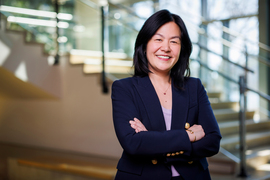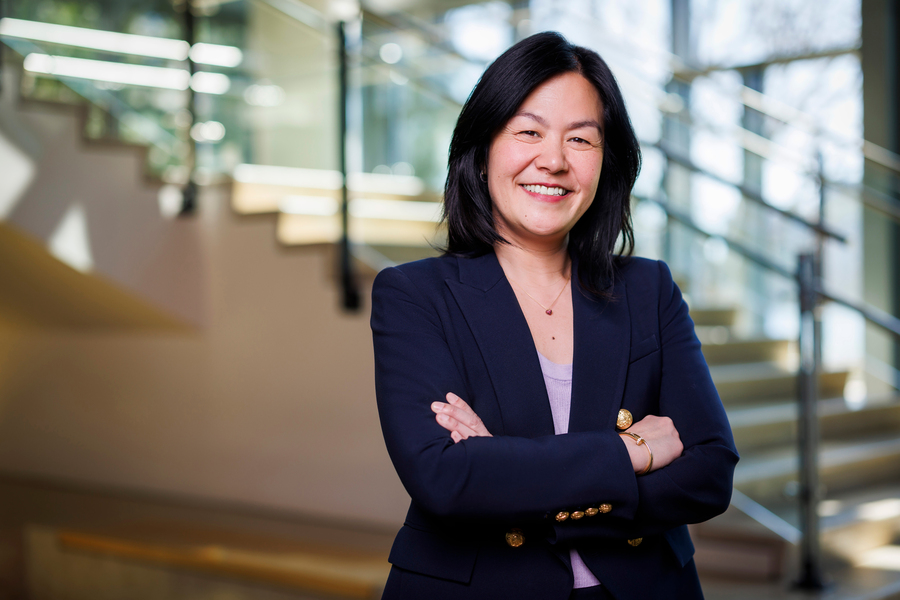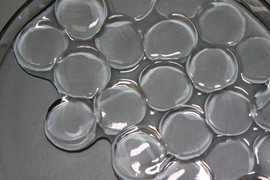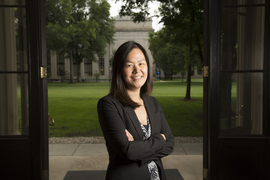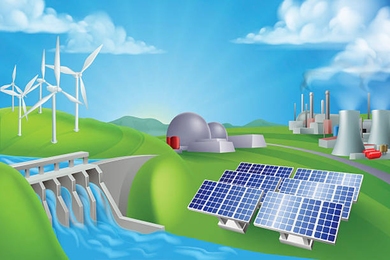Evelyn Wang ’00 knows a few things about engineering solutions to hard problems. After all, she invented a way to pull water out of thin air.
Now, Wang is applying that problem-solving experience — and an enduring sense of optimism — toward the critical issue of climate change, to strengthen the American energy economy and ensure resilience for all.
Wang, a mechanical engineering professor by trade, began work this spring as MIT’s first vice president for energy and climate, overseeing the Institute’s expanding work on climate change. That means broadening the Institute’s already-wide research portfolio, scaling up existing innovations, seeking new breakthroughs, and channeling campus community input to drive work forward.
“MIT has the potential to do so much, when we know that climate, energy, and resilience are paramount to events happening around us every day,” says Wang, who is also the Ford Professor of Engineering at MIT. “There’s no better place than MIT to come up with the transformational solutions that can help shape our world.”
That also means developing partnerships with corporate allies, startups, government, communities, and other organizations. Tackling climate change, Wang says, “requires a lot of partnerships. It’s not an MIT-only endeavor. We’re going to have to collaborate with other institutions and think about where industry can help us deploy and scale so the impact can be greater.”
She adds: “The more partnerships we have, the more understanding we have of the best pathways to make progress in difficult areas.”
From MIT to ARPA-E
An MIT faculty member since 2007, Wang leads the Device Research Lab. Along with collaborators, she identifies new materials and optimizations based on heat and mass transport processes that unlock the creation of leading-edge innovations. Her development of the device that extracts water from even very dry air led Foreign Policy Magazine to name her its 2017 Global ReThinker, and she won the 2018 Eighth Prince Sultan bin Abdulaziz International Prize for Water.
Her research also extends to other areas such as energy and desalination research. In 2016, Wang and several colleagues announced a device based on nanophotonic crystals with the potential to double the amount of power produced by a given area of solar panels, which led to one of her graduate researchers on the project to co-found the startup Antora Energy. More recently, Wang and colleagues developed an aerogel that improves window insulation, now being commercialized through her former graduate students in a startup, AeroShield.
Wang also spent two years recently as director of the U.S. Department of Energy’s Advanced Research Projects Agency-Energy (ARPA-E), which supports early-stage R&D on energy generation, storage, and use. Returning to MIT, she began her work as vice president for energy and climate in April, engaging with researchers, holding community workshops, and planning to build partnerships.
“I’ve been energized coming back to the Institute, given the talented students, the faculty, the staff. It’s invigorating to be back in this community,” Wang says. “People are passionate, excited, and mission-driven, and that’s the energy we need to make a big impact in the world.”
Wang is also working to help align the Institute’s many existing climate efforts. This includes the Climate Project at MIT, an Institute-wide presidential initiative announced in 2024, which aims to accelerate and scale up climate solutions while generating new tools and policy proposals. All told, about 300 MIT faculty conduct research related to climate issues in one form or another.
“The fact that there are so many faculty working on climate is astounding,” Wang says. “Everyone’s doing exciting work, but how can we leverage our unique strengths to create something bigger than the sum of its parts? That’s what I’m working toward. We’ve spun out so many technologies. How do we do more of that? How do we do that faster, and in a way so the world will feel the impact?”
A deep connection to campus — and strong sense of optimism
Understanding MIT is one of Wang’s strengths, given that she has spent over two decades at the Institute.
Wang earned her undergraduate degree from MIT in mechanical engineering, and her MS and PhD in mechanical engineering from Stanford University. She has held several chaired faculty positions at MIT. In 2008, Wang was named the Esther and Harold E. Edgerton Assistant Professor; in 2015, she was named the Gail E. Kendall Professor; and in 2021, she became the Ford Professor of Engineering. Wang served as head of the Department of Mechanical Engineering from 2018 through 2022.
As it happens, Wang’s parents, Kang and Edith, met as graduate students at the Institute. Her father, an electrical engineer, became a professor at the University of California at Los Angeles. Wang also met her husband at MIT, and both of her brothers graduated from the Institute.
Along with her deep institutional knowledge, administrative experience, and track record as an innovator, Wang is bringing several other things to her new role as vice president for energy and climate: a sense of urgency about the issue, coupled with a continual sense of optimism that innovators can meet society’s needs.
“I think optimism can make a difference, and is great to have in the midst of collective challenge,” Wang says. “We’re such a mission-driven university, and people come here to solve real-world problems.”
That hopeful approach is why Wang describes the work as not only as a challenge but also a generational opportunity. “We have the chance to design the world we want,” she says, “one that’s cleaner, more sustainable and more resilient. This future is ours to shape and build together.”
Wang thinks MIT contains many examples of world-shaping progress, She cites MIT’s announcement this month of the creation of the Schmidt Laboratory for Materials in Nuclear Technologies, at the MIT Plasma Science and Fusion center, to conduct research on next-generation materials that could help enable the construction of fusion power plants. Another example Wang references is MIT research earlier this year on developing clean ammonia, a way to make the world’s most widely-produced chemical with drastically-reduced greenhouse gas emissions.
“Those solutions could be breakthroughs,” Wang says. “Those are the kinds of things that give us optimism. There’s still a lot of research to be done, but it suggests the potential of what our world can be.”
Optimism: There’s that word again.
“Optimism is the only way to go,” Wang says. “Yes, the world is challenged. But this is where MIT’s strengths — in research, innovation, and education — can bring optimism to the table.”
